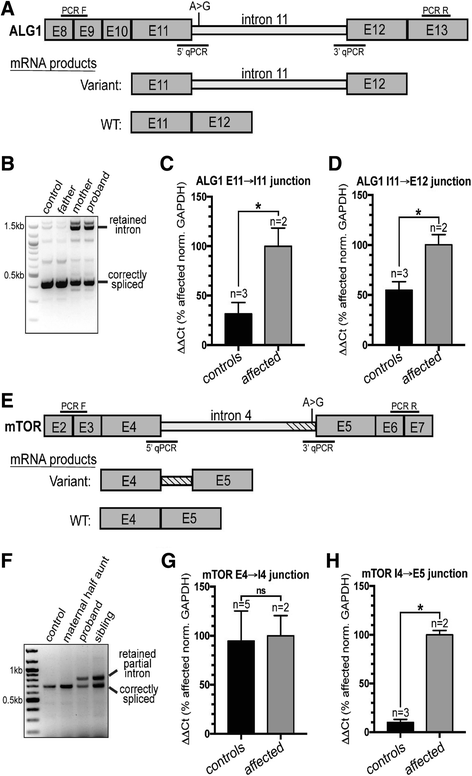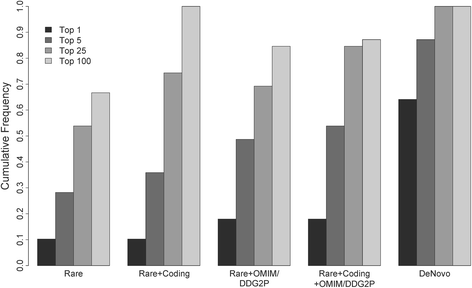Genomic diagnosis for children with intellectual disability and/or developmental delay
- PMID: 28554332
- PMCID: PMC5448144
- DOI: 10.1186/s13073-017-0433-1
Genomic diagnosis for children with intellectual disability and/or developmental delay
Abstract
Background: Developmental disabilities have diverse genetic causes that must be identified to facilitate precise diagnoses. We describe genomic data from 371 affected individuals, 309 of which were sequenced as proband-parent trios.
Methods: Whole-exome sequences (WES) were generated for 365 individuals (127 affected) and whole-genome sequences (WGS) were generated for 612 individuals (244 affected).
Results: Pathogenic or likely pathogenic variants were found in 100 individuals (27%), with variants of uncertain significance in an additional 42 (11.3%). We found that a family history of neurological disease, especially the presence of an affected first-degree relative, reduces the pathogenic/likely pathogenic variant identification rate, reflecting both the disease relevance and ease of interpretation of de novo variants. We also found that improvements to genetic knowledge facilitated interpretation changes in many cases. Through systematic reanalyses, we have thus far reclassified 15 variants, with 11.3% of families who initially were found to harbor a VUS and 4.7% of families with a negative result eventually found to harbor a pathogenic or likely pathogenic variant. To further such progress, the data described here are being shared through ClinVar, GeneMatcher, and dbGaP.
Conclusions: Our data strongly support the value of large-scale sequencing, especially WGS within proband-parent trios, as both an effective first-choice diagnostic tool and means to advance clinical and research progress related to pediatric neurological disease.
Keywords: CSER; Clinical sequencing; De novo; Developmental delay; Intellectual disability.
Figures


Similar articles
-
Trio-whole exome sequencing reveals the importance of de novo variants in children with intellectual disability and developmental delay.Sci Rep. 2024 Nov 11;14(1):27590. doi: 10.1038/s41598-024-79431-x. Sci Rep. 2024. PMID: 39528574 Free PMC article.
-
Systematic reanalysis of genomic data improves quality of variant interpretation.Clin Genet. 2018 Jul;94(1):174-178. doi: 10.1111/cge.13259. Epub 2018 May 10. Clin Genet. 2018. PMID: 29652076 Free PMC article.
-
Whole Exome Sequencing and Panel-Based Analysis in 176 Spanish Children with Neurodevelopmental Disorders: Focus on Autism Spectrum Disorder and/or Intellectual Disability/Global Developmental Delay.Genes (Basel). 2024 Oct 11;15(10):1310. doi: 10.3390/genes15101310. Genes (Basel). 2024. PMID: 39457434 Free PMC article.
-
A clinical approach to developmental delay and intellectual disability.Clin Med (Lond). 2017 Dec;17(6):558-561. doi: 10.7861/clinmedicine.17-6-558. Clin Med (Lond). 2017. PMID: 29196358 Free PMC article. Review.
-
[Genetic analysis and prenatal diagnosis for a Chinese pedigree affected with Bainbridge-Ropers syndrome].Zhonghua Yi Xue Yi Chuan Xue Za Zhi. 2022 Nov 10;39(11):1228-1232. doi: 10.3760/cma.j.cn511374-20210813-00667. Zhonghua Yi Xue Yi Chuan Xue Za Zhi. 2022. PMID: 36317208 Review. Chinese.
Cited by
-
Health Care Costs After Genome-Wide Sequencing for Children With Rare Diseases in England and Canada.JAMA Netw Open. 2024 Jul 1;7(7):e2420842. doi: 10.1001/jamanetworkopen.2024.20842. JAMA Netw Open. 2024. PMID: 38985473 Free PMC article.
-
Identification of novel SHANK2 variants in two Chinese families via exome and RNA sequencing.Front Neurosci. 2023 Nov 24;17:1275421. doi: 10.3389/fnins.2023.1275421. eCollection 2023. Front Neurosci. 2023. PMID: 38075274 Free PMC article.
-
An Epilepsy-Associated GRIN2A Rare Variant Disrupts CaMKIIα Phosphorylation of GluN2A and NMDA Receptor Trafficking.Cell Rep. 2020 Sep 1;32(9):108104. doi: 10.1016/j.celrep.2020.108104. Cell Rep. 2020. PMID: 32877683 Free PMC article.
-
Pathogenic WDFY3 variants cause neurodevelopmental disorders and opposing effects on brain size.Brain. 2019 Sep 1;142(9):2617-2630. doi: 10.1093/brain/awz198. Brain. 2019. PMID: 31327001 Free PMC article.
-
Comprehensive genetic analysis of 57 families with clinically suspected Cornelia de Lange syndrome.J Hum Genet. 2019 Oct;64(10):967-978. doi: 10.1038/s10038-019-0643-z. Epub 2019 Jul 23. J Hum Genet. 2019. PMID: 31337854
References
-
- Sun F, Oristaglio J, Levy SE, Hakonarson H, Sullivan N, Fontanarosa J, et al. Genetic testing for developmental disabilities, intellectual disability, and autism spectrum disorder. Rockville: Agency for Healthcare Research and Quality; 2015. - PubMed
Publication types
MeSH terms
Grants and funding
LinkOut - more resources
Full Text Sources
Other Literature Sources
Medical
Molecular Biology Databases

